Hardening Your Home With Defensible Space

Defensible space is a critical buffer between your home and the surrounding vegetation that can help slow the spread of wildfires. By creating and maintaining defensible space, you can reduce your home’s risk of igniting from flames, radiant heat, or airborne embers.
This article guides you through the principles of defensible space and how to design and maintain it effectively. Fire experts typically divide defensible space into zones, each with specific guidelines for plant management and Landscape Design.
Zone 1: Immediate Zone (0–5 Feet from Your Home)
The immediate zone, often referred to as the “home ignition zone,” is the most critical area to protect, as it includes your home’s immediate surroundings. Wildfire experts recommend maintaining this area as free from combustible materials as possible.
Keep It Clear: Remove all dead vegetation, leaf litter, and dry plant material. Avoid having any Flammable materials directly adjacent to your home, including firewood, Mulch, and dead plants.
Use Non-Combustible Materials: Consider using Gravel, rocks, or other non-flammable materials instead of wood mulch for landscaping. Pavers or stones can serve as a fire break and add aesthetic value.
Trim Overhanging Branches: Trim any tree branches that hang over the roof or are within 10 feet of your home. Also, remove vines or other plants that could spread flames to walls or the roof.
Irrigate Regularly: In this zone, plants should be well-watered and maintained. Drought-stressed plants are more likely to ignite, so water any landscaping plants regularly and keep them healthy.
Flammable Liquids: Store all combustible and / or flammable liquids and materials away from ignition type sources.

Zone 2: Intermediate Zone (5–30 Feet from Your Home)
The intermediate zone provides a buffer between your home and the surrounding landscape. The goal here is to create breaks that reduce the fire’s intensity as it approaches your home.
Create Fuel Breaks: Break up continuous layers of plants to slow down fire spread. For example, create islands of vegetation separated by areas of rocks or gravel to reduce the continuity of fuel.
Space Out Trees and Shrubs: Trees and large shrubs should be spaced so that their branches do not touch. The general rule is to keep at least 10 feet between the tips of tree branches.
Keep Grass Low: Mow grass regularly, keeping it no taller than four inches. Dried-out grass can be highly flammable, so it’s best to keep it trimmed and watered.
Use Fire-Resistant Plants: Choose plants with high moisture content, low resin, and low oil levels, as these types are less likely to ignite. Native, fire-resistant plants are ideal for creating a safer landscape and can be better adapted to your climate.
Zone 3: Extended Zone (30–100 Feet from Your Home)
This zone serves as a final buffer, focusing on reducing the speed and intensity of a wildfire as it approaches your home. The extended zone may include other structures, fences, and larger vegetation.
Thin Out Vegetation: Thin out trees and shrubs so that there is ample space between them. This reduces the chance of flames traveling through treetops, known as “crown fires.”
Create Horizontal and Vertical Spacing: Horizontal spacing is essential between tree canopies, but it’s also important to eliminate “ladder fuels.” Ladder fuels are plants or shrubs that can carry fire from the ground up into the tree canopy. Ensure vertical clearance by trimming or removing smaller plants beneath larger trees.
Remove Dead Material: Regularly clear this area of any fallen leaves, branches, or other dead material. Large, downed trees should also be removed or cut into manageable pieces and kept at a safe distance from other vegetation.
Consider Hardscaping: In the extended zone, hardscaping elements such as gravel paths, retaining walls, and rock gardens can break up the vegetation and slow down advancing flames.

Choosing Fire-Resistant Plants
When designing defensible space, choosing fire-resistant plants can enhance the safety of your landscape. Fire-resistant plants typically have the following characteristics:
High Moisture Content: Succulent plants and those with fleshy leaves retain moisture and are less likely to burn.
Low Resin and Oil Content: Plants with high resin or oil content, like pines and junipers, ignite more easily. Choose plants with low oil content instead.
Slow Growth: Slow-growing plants tend to require less maintenance and produce less fuel, making them safer choices for defensible space.
Native Plants: Native plants are well-suited to the local climate and can be more drought-tolerant, reducing the need for frequent irrigation.
Popular fire-resistant choices include succulents, agave, certain types of sage, and Deciduous trees like Maple or oak. Contact your local fire department or cooperative extension for a list of recommended fire-resistant plants in your area.
Maintaining Your Defensible Space
Creating defensible space isn’t a one-time effort; it requires ongoing maintenance to remain effective. Regularly assess each zone and adjust your landscaping as necessary to reduce fire risks:
Prune and Trim: Maintain proper spacing between plants, keep branches pruned, and trim any overgrown vegetation that could serve as a fire ladder.
Rake and Clean: Remove leaf litter, pine needles, and other debris that can accumulate around your home. Make sure gutters and roofs are free of leaves and twigs as well.
Clear Access Points: Ensure your home’s Driveway and other access points are clear for emergency vehicles. Trim any overhanging branches and remove plants encroaching on these paths.
Check for New Growth: Especially in the spring and summer, new growth can quickly turn into a fire hazard. Regularly assess your landscape and thin out any excessive vegetation that could pose a risk.
Wrap-Up
By establishing and maintaining defensible space around your home, you significantly reduce the likelihood of ignition during a wildfire. Properly managed zones help slow the spread of flames and provide a buffer for firefighters, improving the odds of saving your home.
Coupled with structural hardening, defensible space is a key component of any wildfire preparedness plan. Through careful planning, plant selection, and routine maintenance, you can protect your home and create a safer environment for your family when wildfires threaten.